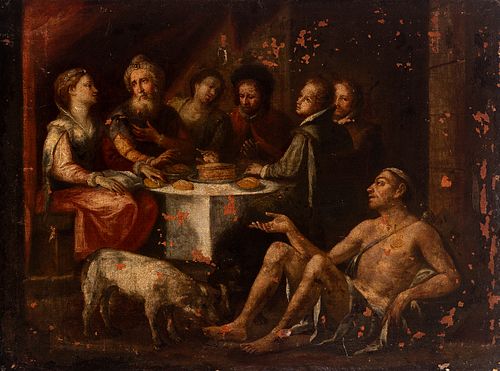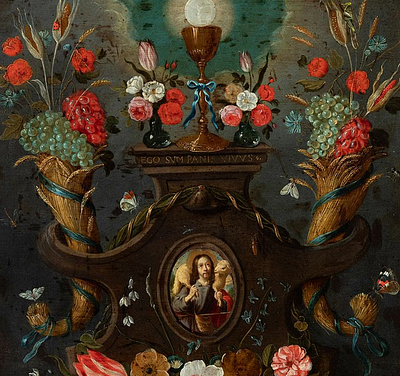Andalusian School, Circle of JUAN DE SEVILLA ROMERO (Granada, 1643-1695); second half of the 17th century. "The rich Epulon and the poor Lazarus". O
Lot 21
About Seller
Setdart Auction House
Carrer Aragó 346
Barcelona
Spain
Setdart Subastas was born in 2004 and is currently the first online art auction in Spain with solidity, prestige and reliability guaranteed by our more than 60,000 users. Setdart has a young, dynamic and enterprising team ready to successfully manage the purchase and sale of art works through custom...Read more
Estimate:
EUR€1,700 - EUR€1,900
$1,789.47 - $2,000
Absentee vs Live bid
Two ways to bid:
- Leave a max absentee bid and the platform will bid on your behalf up to your maximum bid during the live auction.
- Bid live during the auction and your bids will be submitted real-time to the auctioneer.
Bid Increments
| Price | Bid Increment |
|---|---|
| EUR€0 | EUR€10 |
| EUR€200 | EUR€25 |
| EUR€500 | EUR€50 |
| EUR€1,000 | EUR€100 |
| EUR€3,000 | EUR€200 |
| EUR€5,000 | EUR€500 |
| EUR€10,000 | EUR€1,000 |
| EUR€20,000 | EUR€2,000 |
| EUR€50,000 | EUR€5,000 |
About Auction
By Setdart Auction House
Sep 21, 2021
Set Reminder
2021-09-21 10:00:00
2021-09-21 10:00:00
America/New_York
Bidsquare
Bidsquare : 21st September - ARAS JÁUREGUI Private Collection - Old Masters, 19th & 20th Century
https://www.bidsquare.com/auctions/setdart-auction-house/21st-september---aras-j-uregui-private-collection---old-masters-19th-20th-century-7429
Setdart Auction House sofia@setdart.com
Setdart Auction House sofia@setdart.com
- Lot Description
Andalusian School, Circle of JUAN DE SEVILLA ROMERO (Granada, 1643-1695); second half of the 17th century. "The rich Epulon and the poor Lazarus". Oil on canvas. Re-drawn. It presents faults and relevant damages. Size: 75 x 103 cm. In this work is represented the parable of the rich Epulion and Lazarus, which is gathered in the Gospel of Luke. The story is narrated by Jesus, who tells his disciples and some Pharisees, the relationship, during life and after death, between an anonymous rich man and a poor beggar named Lazarus: "There was a rich man who was clothed in purple and fine linen and lived in luxury every day. At his gate stood a beggar named Lazarus, covered with sores and longing to eat what fell from the rich man's table. Even the dogs came and licked his sores. The time came when the beggar died and the angels carried him to Abraham's side. The rich man also died and was buried. In Hades, where he was in torment, he looked up and saw Abraham in the distance, with Lazarus beside him. Then he cried out to him, Father Abraham, have mercy on me and send Lazarus to dip the tip of his finger in water and cool my tongue, for I am in agony in this fire. But Abraham answered, Son, remember that in your life you received your good things, while Lazarus received bad things, but now he is comforted here and you are in agony. And besides all this, between us and you there is a great gulf. He answered, "Then I beg you, father, send Lazarus to my family, for I have five brothers. Let him warn them, lest they also come to this place of torment". Abraham replied, "They have Moses and the prophets; let them listen to them." "No, father Abraham,' he said, 'but if anyone from among the dead goes to them, they will repent. He said to him, 'If they do not listen to Moses and the Prophets, they will not be convinced, even if someone rises from the dead'". This scene represents the moment when Lazarus, with his lacerated body, begs for alms, while the rich man, seated at the table with his five brothers, enjoys his supper, oblivious to Lazarus' suffering. The appearance of the dog, licking Lazarus' sores, has led to the similarity of the latter with the figure of Saint Roch, just as his name has sometimes been identified as Lazarus of Bethany, although the two figures are not related.
- Shipping Info
-
In-house shipping available. Please inquire at admin@setdart.com.
-
- Buyer's Premium



 EUR
EUR CAD
CAD AUD
AUD GBP
GBP MXN
MXN HKD
HKD CNY
CNY MYR
MYR SEK
SEK SGD
SGD CHF
CHF THB
THB

















